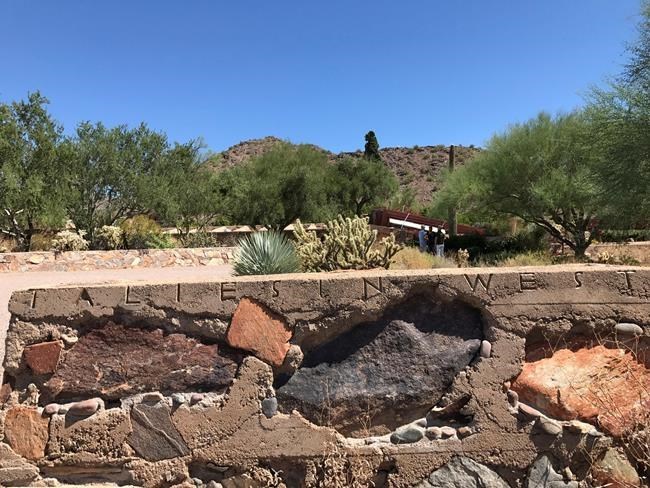
This Sept. 24, 2017 photo shows the words "Taliesin West" carved into a rock wall with the desert landscape visible in the background in Scottsdale, Ariz. The complex served as the winter home of architect Frank Lloyd Wright in Scottsdale, Arizona from 1937 until his death in 1959 at age 91. The original Taliesin, Wright's primary home in southwestern Wisconsin, where he was born, was named after a 6th century Welsh bard whose name means "shining brow." (AP Photo/Anita Snow)
Republished November 27, 2017 - 8:47 AM
Original Publication Date November 27, 2017 - 7:21 AM
SCOTTSDALE, Ariz. - Each year when the sizzling temperatures finally dipped in the southern Arizona desert, architect Frank Lloyd Wright and a small band of young apprentices would start the annual cross-country migration from Spring Green, Wisconsin, just in time to escape the Midwestern snow.
Twenty-six miles northeast of Phoenix, Wright's students built the desert shelters they slept in during the winter term at his School of Architecture, where bobcats, coyotes, and pig-like mammals called javelinas (HAV-ah-lee-nas) wandered outside after sundown. Lacking electricity, running water, doors or windows, the buildings were wide open to nature. Meals were shared as a group.
From 1937 until Wright's death in 1959 at age 91, the desert site known as Taliesin West was the winter home and laboratory of America's premier architect. The original Taliesin, Wright's primary home in southwestern Wisconsin, was named after a 6th century Welsh bard whose name means "shining brow."
Built on the Arizona desert's hard floor, Wright constructed Taliesin West's structures with redwood beams and large rocks embedded in concrete. The buildings initially were covered with translucent canvas to let light in, but were later replaced with more durable plastic because of the sun's brutal rays. Windows were large openings without glass.
Today, the 491-acre (198-hectare) site in the foothills of the McDowell Mountains remains the winter home of the graduate school, which offers an accredited Master of Architecture (M. Arch) degree. It's also year-round headquarters of The Frank Lloyd Wright Foundation, which oversees the architect's works.
The Scottsdale property is also a magnet for fans of the man who designed some of the most innovative buildings in America, attracting more than 100,000 visitors each year to this National Historic Landmark. Although final numbers for 2017 aren't in, Wright Foundation officials say visits appear to be up significantly as the architect's admirers mark the 150th anniversary of his birth, June 8, 1867.
The site was "nothing but one, big open question" back in 1937, when Wright bought it from a state land officer looking to unload it on a fool, one-time Wright apprentice Vernon D. Swaback half-jokingly told a group gathered at Taliesin West in October. Wright had already brought his students to the Arizona desert for four winters and wanted to build a more permanent camp.
"With total volunteer labour, he takes sand out of the wash, and takes stone from the base of the mountains and proceeds to build a national landmark," said Swaback, a 78-year-old architect who was just starting out when he met his teacher.
Today, the only way to get a close look at Wright's organic architecture uniting art and nature in Arizona's Sonoran desert is through one of several guided tours. Priced at $36 for walk-up ticket ($34 in advance), the 1 1/2-hour "Insights Tour" takes visitors throughout a complex of buildings connected by walkways and terraces with dramatic desert vistas in the background.
One stop takes visitors by the drafting room where many of Wright's famous buildings were designed, including the Guggenheim Museum in New York. Here, Wright's students began mapping out their own creations on the sloping desks that look out at the desert through broad windows.
At another stop, Wright fans sit in a long, rectangular living area called the "garden room," where the architect and his third wife, Olgivanna, entertained friends. At one end is one of the fireplaces that Wright typically used to anchor his structures.
Visitors see a half-sunken theatre, known as the cabaret, with a stage and small dining tables. They also stop by a multipurpose hall known as the music pavilion and see Wright's office and private quarters.
More elaborate tours are available, including a two-hour, $40 "Night Lights" tour on Friday evenings during some parts of the year, and a three-hour $75 "Behind the Scenes" tour for super enthusiasts that features mid-morning tea and snacks in the dining room and a more extensive viewing of the desert grounds. On Saturdays from mid-November through April, the students lead two-hour $45 tours of the desert shelters that are still used for their housing today.
Taliesin West is considered among Wright's masterpieces. He lived to see more than 500 of his designs realized, including homes, offices and schools. In addition to the Guggenheim, among the best known is Fallingwater, a modernist house built in stacks over a Pennsylvania waterfall. Other notable projects were the 19-story Price Tower in Bartlesville, Oklahoma; Florida Southern College in Lakeland, Florida; and the Ennis House, a Los Angeles dwelling with a Mayan temple design.
But here, visitors can gaze out at the Arizona desert landscape that Wright and his students saw from the drafting room. Hills covered with scrub brush loom in the distance and quails and roadrunners skitter amid the green-trunked palo verde trees and columnar saguaros, a view Wright once described as "a look over the rim of the world."
___
If You Go...
TALIESIN WEST: 12621 N. Frank Lloyd Wright Blvd. (for GPS, 12345 N. Taliesin Drive), Scottsdale, Arizona; http://franklloydwright.org/taliesin-west/ or 480-860-2700. Open daily September-May except Thanksgiving, Christmas, Easter. In June, July and August, closed Tuesday-Wednesday. Insights tour offered throughout the day beginning at 9 a.m., $36. Website lists various other tours, schedules and prices. Tours sell out so book ahead.
News from © The Associated Press, 2017